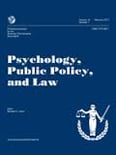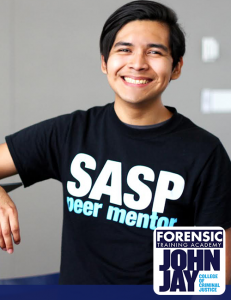 As guilty pleas are on the rise worldwide, we need to invest more effort into understanding what drives this phenomenon. This is the bottom line of a recently published article in Psychology, Public Policy, and Law. Below is a summary of the research and findings as well as a translation of this research into practice.
As guilty pleas are on the rise worldwide, we need to invest more effort into understanding what drives this phenomenon. This is the bottom line of a recently published article in Psychology, Public Policy, and Law. Below is a summary of the research and findings as well as a translation of this research into practice.

Featured Article | Psychology, Public Policy, and Law | 2017, Vol. 23, No. 4, 458–471
Understanding Guilty Pleas Through the Lens of Social Science
Authors
Allison D. Redlich, George Mason University
Miko M. Wilford, University of Massachusetts Lowell
Shawn Bushway, University at Albany
Abstract
The adjudication of crime by guilty plea has been on the rise globally for at least the last 30 years. Few countries, however, have accepted pleas to the degree of the United States, whose highest court recently acknowledged a criminal justice system near-synonymous with a “system of pleas, not a system of trials” (Lafler v. Cooper, 2012, p. 3). The present article provides an overview of this justice system wherein many pleas are bargained between the defense and prosecution. Our purpose here is twofold: first to review psychological and other social scientific research on the theoretical and practical reasons underlying the process of pleading guilty, and second, to identify research questions and methods that have yet to be, but need to be, asked and conducted in relation to guilty pleas.
Keywords
plea bargains, false guilty pleas, adjudication, legal competence
Summary of the Research
“The U.S. criminal justice system is equated with one of pleas. Almost all adjudicated defendants (about 95%) are convicted without trials, and most of these defendants agree to plead guilty in exchange for a “bargain” (typically a discounted sentence or a lesser charge than if convicted at trial). Across the globe, guilty pleas are also becoming more prevalent, with at least 65 countries using the practice in some form, the majority of whom adopted it within the past 25 years.” (p. 458).
“To understand the criminal justice system and the decisions of the actors operating within it—arguably an overarching aim of the field of psychology and law and related disciplines— one must also understand the guilty plea process and its underlying policies.” (p. 458)
“Our purpose here is twofold: first to review psychological and other social scientific research on the theories and factors underlying the process of pleading guilty; and second, to identify novel theoretical and methodological approaches to studying guilty pleas. In addition, we suggest ways forward for translating the science into practice and policy.” (p. 458)
“What does it mean for a defendant to plead guilty? […] First, in most cases, pleading guilty means that a defendant is willing to accept responsibility for the crime. […] Regardless of the guilty plea type, the defendant is convicted. With this conviction comes many direct and collateral consequences (e.g., not being eligible to vote or own a gun, and/or being barred from certain types of employment or public housing options).” (p. 459)
“A second defining feature of a guilty plea is a waiver of certain constitutional rights. By agreeing to plead guilty, defendants cede many rights including, but not limited to: the right to a trial/jury of one’s peers (and all the rights therein, such as confronting accusers and subpoenaing witnesses), the right to have the prosecution prove its case beyond a reasonable doubt, and the right to mount a defense. […] The plea decision and concomitant waiver of rights are required to be made knowingly, intelligently, and voluntarily. […] In reality, defendants often have little time to deliberate and make an informed decision. […] There have been a growing number of recorded exploding offers in which defendants are forced to accept a plea within a short timeframe (e.g., 24-hr or less) before it is replaced with a less favorable offer. […] It is even unclear how many defendants who plead guilty possess the capacity to make a knowing, intelligent, voluntary decision (i.e., legal competence).” (p. 459)
“A third characteristic that typifies pleading guilty is leniency. Certainly, a defendant can plead guilty without receiving anything in return. For the most part, however, the majority of guilty pleas are the result of plea bargains—the defendant receives leniency in the form of reduced charges, sentences and collateral consequences (e.g., not having to register as a convicted sex offender), and/or altered factual elements of the crime. The latter, fact bargaining, may manifest in hiding aggravating factors of the crime (such as the use of a weapon) which in turn can reduce the charge, sentence, and/or collateral consequences. The leniency offered during plea bargaining is referred to as the plea discount (or the trial penalty) and varies on a continuum.” (p. 459–460)
“Finally, it is important to note that guilty pleas conflate the guilt-innocence and sentencing phases, phases that are distinctly separate in trials. By pleading guilty, in exchange for leniency, defendants’ guilt or innocence is decided without the benefit of investigation, cross-examination of accusers, or a jury of ones’ peers.” (p. 460)
“Analyses of real-world cases indicate that defendants confronted with stronger cases (i.e., higher probability of conviction at trial) and less severe charges have been found to be more likely to plead guilty. Prosecutors and defense attorneys also typically opine that the “strength of the evidence” is the driving force behind guilty pleas.” (p. 460)
“Although it is important to acknowledge the limits of individual differences given the near-ceiling rate of plea acceptance, it is the case that certain dispositional characteristics—such as young age and cognitive impairments—will affect whether the plea decision is knowing and voluntary. It is also important to acknowledge that while the decision to accept or reject a plea offer is ultimately the defendant’s, a number of social influence factors play a role as well.” (p. 461)
“Outside criminology, bargaining in the shadow of the trial (hereafter referred to as the “shadow” model) is the primary model used to explain the existence of, and variation in the plea discount. […] In this model, a defendant pleads guilty if the offered sentence is less than or equal to his expected value of the trial. Trials have uncertain outcomes; economists use the concept of expected value to evaluate uncertain outcomes. An expected value is equal to the sum of all the possible outcomes, weighted by the probability of each outcome actually occurring. […] Defendants make decisions about accepting pleas based on the expected value of the plea (assuming that they have perfect information about their uncertainty) and their risk preferences.” (p. 461–462)
“The shadow model is not a direct model of prosecutors’ behavior—it is intended to be a model of defendant choices – but the model can frame prosecutors’ (and defense attorneys’) related plea decisions. […] Nothing in the model stops a prosecutor from offering a plea deal that is lower than the expected value of the trial, even dramatically lower. […] The actual offer from the prosecutor depends in part on the objectives of the prosecutor. The only prediction from the shadow model refers to the minimum plea discount needed to induce a rational defendant to plead guilty.” (p. 462)
“The trial penalty model is an alternative to the shadow model, built on fundamentally different principles. This model began from an organizational paradigm that emphasizes that judges, prosecutors and defense attorneys within a jurisdiction are part of an interdependent workgroup who work toward shared goals such as disposing of cases efficiently and minimizing uncertainty. Within this framework, it is predicted that the workgroup will establish norms, or going rates, for defendants who are willing to plead guilty. Over time, theorists have extended this basic framework. […] The difference between plea sentences and trial sentences are clearly perceived as a trial penalty rather than a plea discount. The trial penalty exists literally as a way of punishing defendants who do not “follow the rules” and accept the going rate established by the work group. In other words, actors who do not accept responsibility by pleading guilty face a trial penalty for exercising their right to trial. This penalty can be quite large, even over 50%.” (p. 463)
“Two possible variables that could predict the size [of the penalty] have been suggested. The first variable relates to the strength of the case. There appears to be some consensus that the penalty increases when defendants insist on their right to trial in standard cases where there is little doubt about the defendant’s guilt, particularly to members of the courtroom workgroup […] The second variable relates to the severity of the crime. There is more leeway to go to trial if the going rate is higher, again, because there is more at stake.” (p. 463)
“Neither the shadow model nor the trial penalty model provide an explicit predictive role for a defendant’s innocence. […] Research has dependably demonstrated that guilty people in contrast to innocent ones are more likely to plead guilty, even when the probability of conviction is held constant. […] However, whereas innocent individuals are less likely to plead than guilty ones, growing evidence indicates that factual guilt is neither a legal or psychological requirement for a guilty plea.” (p. 463)
“Prospect theory may help to explain the effect of innocence on plea decisions. […] The potential value of each decision outcome must be measured in terms of this reference point—whether the ultimate outcome will be a gain or a loss. […] Guilty individuals should be more likely to perceive conviction and punishment as the natural result of their crime(s) whereas innocent individuals should perceive any punishment as an undeserved loss. Guilty individuals should therefore perceive the offers made during plea negotiations as potential gains (or savings) to their otherwise more severe punishment. […] [The innocence of innocent individuals] should lead them to perceive any punishment as a loss. Prospect theory would then predict […] that innocent individuals should prefer to face the possibility of greater risk at trial in an effort to avoid any loss.” (p. 463–464)
“According to prospect theory, there is a point at which losses become so large that risk preferences can be overcome. In other words, if the potential cost (plea discount or trial penalty) or risk (probability of conviction) of rejecting a plea is substantial, then it is more likely that innocent individuals will ignore their preference for risk and opt for the certainty of a plea (which carries a substantially lower cost).” (p. 464)
“Defendants often plead guilty simply because it is a “good deal.” Plea bargains are near-synonymous with leniency. Research has clearly shown that sentence and charge reductions provide significant motivations to plead guilty. […] The potential sentence faced at trial has also been shown to affect the recommendations of defense attorneys and plea-related decisions of prosecuting attorneys. […] Defendants may plead guilty because they feel coerced. Indeed, an often-cited reason for having pled guilty relates to pressure. The pressure can originate from various sources, but often comes from attorneys and family/friends. […] Advice from defense attorneys led defendants to accept plea offers that were presented as more expedient. […] The accessibility of quality defense attorneys who can ameliorate some of the prosecutorial pressures defendants face is an important factor in plea decisions. […] Sometimes (such as in lower-level cases) defendants plead guilty to be done with the process, rather than go to trial which entails prolonging the case, missing work, spending (more) money on attorneys, and so forth. […] Guilty pleas also serve to reduce uncertainty. In contrast to trials, guilty pleas allow for relatively certain outcomes2 for defendants and attorneys.” (p. 464)
“Guilty pleas, as they occur in the real world, can be quite difficult to study from a stringent, pure-science perspective. The process of plea negotiation lacks transparency and is driven largely by jurisdictional differences. Although final plea agreements must be recorded and maintained on public record, from a psychological perspective, those agreements are merely the formulaic outcome of an extremely complex, dynamic and largely secretive process. […] With increased transparency, the study of guilty pleas can continue to move forward, in the field and in the laboratory.” (p. 465)
“The most pressing need on the theoretical front is for more formal modeling of the predominant theories, shadow-of the-trial and trial penalty. The current theoretical formulations of these theories are admittedly simplistic. […] One step in the right direction here would involve theoretical models of various prosecutorial strategies encountered in research. […] The theoretical framing around the question of innocence is arguably more developed […] Theorists in area (primarily economists) need to work more closely with empiricists in this area (primarily psychologists), potentially reformulating these theories for situations that can be more easily tested.” (p. 465)
“Experimental explorations of plea bargaining have been primarily limited to hypothetical vignette studies. […] Future research should continue to search for new empirical paradigms. Currently, experimental investigations of plea-bargaining rely either on vignettes or cheating simulations. Given the differences between these two research methods (both in terms of their limitations and the resources required), the field would greatly benefit from other methods that employ elements of each.” (p. 466)
“Although less commonly employed by psycho-legal scholars, another method used to study guilty pleas has been to analyze administrative data sets. Administrative data are collected by criminal justice agencies, not for research but for the administration of justice. These data, which are becoming computerized, are increasingly available for research purposes. Starting with conviction data sets created by sentencing commissions, researchers have made ready use of these data sets, most often for the purposes of identifying racial disparity in sentencing outcomes. […] In this age of “big data,” obtaining access to large administrative data sets will be key to addressing many of the plea-related questions raised here and elsewhere.” (p. 466)
Translating Research into Practice
“In addition to developing new theoretical and new methodological approaches to the study of guilty pleas, it will be important to develop new models to inform frontline practice and policy. The time is ripe; the highest court in the U.S. has begun to more pointedly regulate guilty pleas with recent landmark cases, such as Padilla v. Kentucky (2011), Lafler v. Cooper (2012), and Missouri v. Frye (2012) […] These cases themselves raise numerous questions (e.g., the knowledge of these court decisions among plea-takers) that researchers should address.” (p. 467)
“It is imperative that the science, in this instance, guilty plea scholarship, keep pace with the law, and the law keep pace with the science […] With this bidirectional exchange of information we can better ensure the integrity of criminal justice practices and policies.” (p. 468)
“There are several obstacles that serve to stymie the translation of research into practice/policy, obstacles which are also likely to be present in disseminating guilty plea scholarship. First is the “single effects” problem, which refers to the tendency for researchers to identify individual effects (such as from manipulating single variables in experiments) in contrast to the broader range of effects that practitioners and policymakers face (e.g., financial and time constraints). In this regard, researchers would do well to replicate studies across numerous jurisdictions, and to the extent possible, replicate studies conducted in the laboratory in the field. […] A second obstacle identified by Wells (2005) is identifying the “right” players who can push reforms forward. […] A third obstacle in effective science-to-practice translation are the perceptions of scientists having a social agenda and being “out of touch with the ‘real world’ of crime”. […] Although science sometimes tells a story that systems may not want to hear, researchers need to find ways to get the message across in palatable manners. […] Finally, as stated by Wells (2005), “data drives science but individual cases drive policymakers” (p. 494). Many policies have derived from high-profile cases, such as Megan’s Law.” (p. 467)
“Whether the controversies surrounding guilty pleas is on the radar of policymakers is unclear, but as the amount of scholarly, advocacy, and media attention continues to grow, we believe changes via judicial decisions and legislative action are distinct possibilities.” (p. 467)
Other Interesting Tidbits for Researchers and Clinicians
“Given the complexity of the plea situation, the presence and advice of others are also likely to interact with other individual difference variables. Future research should continue to examine the “who” (person characteristics) as well as the “why” (reasons for pleading) behind plea decision making.” (p. 461)
“Although there are theoretical models of plea decision making, they remain underdeveloped and undertested. Empirical methods can also be strengthened to address limitations and questions of validity. On the other hand, to be sure, there has been a renewed interest in guilty pleas by scholars from several different disciplines. There have also been recent rulings by the U.S.’s highest court toward regulating the plea process, prompting Justice Scalia to opine that “a whole new boutique of constitutional jurisprudence (‘plea bargaining law’)” was created via the majority decisions in Lafler v. Cooper and Missouri v. Frye (2012). And, there is clear evidence that countries around the world are moving toward a system of pleas. In the span of a decade (1990 –2000), 34 nationalities newly adopted plea bargaining, with the number continuing to rise. Moreover, like the United States, countries such as the United Kingdom, those in the Russian federation, Australia, and others, utilize plea bargaining to resolve the majority of their criminal cases.” (p. 467–468)
Join the Discussion
As always, please join the discussion below if you have thoughts or comments to add!






















